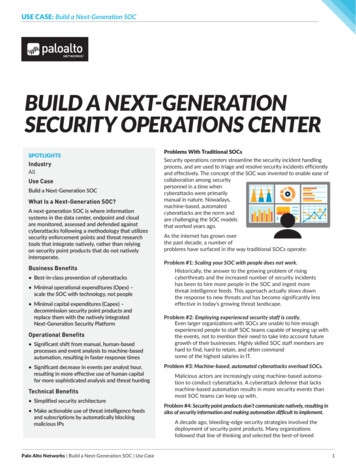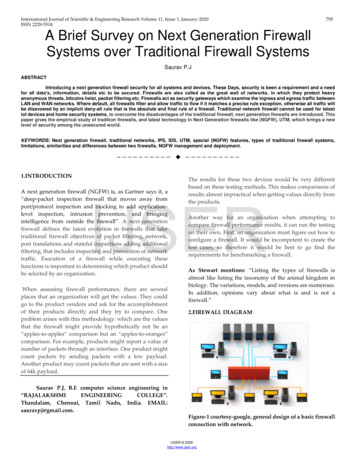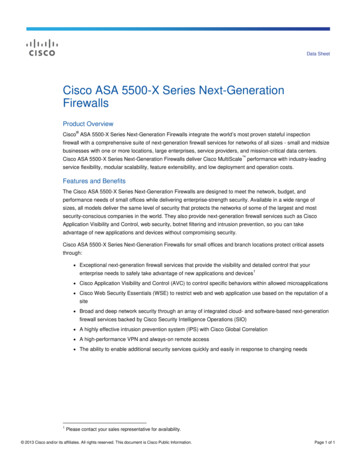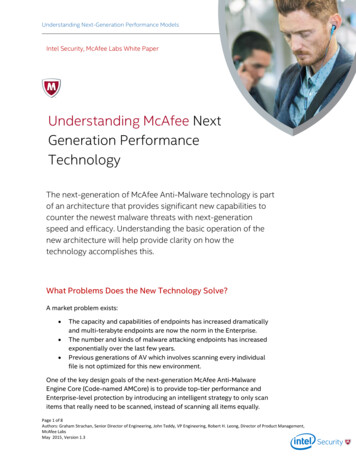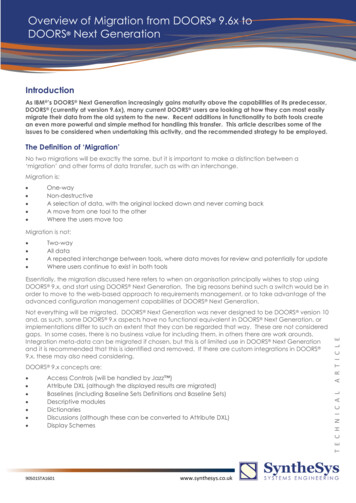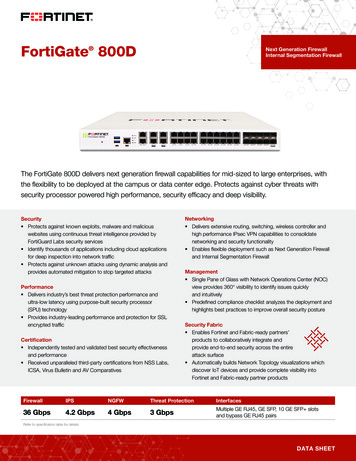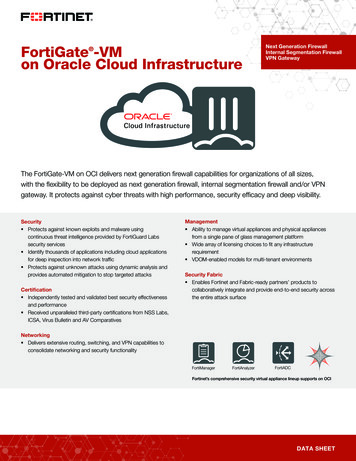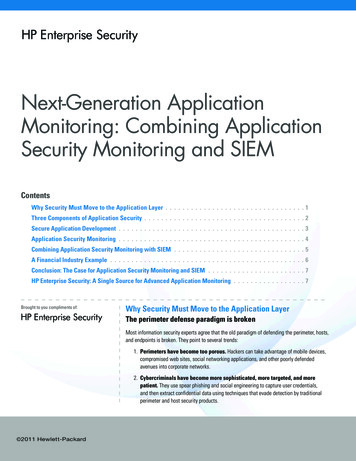
Transcription
Next-Generation ApplicationMonitoring: Combining ApplicationSecurity Monitoring and SIEMContentsWhy Security Must Move to the Application Layer . . . . . . . . . . . . . . . . . . . . . . . . . . . . . . . . . 1Three Components of Application Security . . . . . . . . . . . . . . . . . . . . . . . . . . . . . . . . . . . . . . 2Secure Application Development. . . . . . . . . . . . . . . . . . . . . . . . . . . . . . . . . . . . . . . . . . . . . 3Application Security Monitoring. . . . . . . . . . . . . . . . . . . . . . . . . . . . . . . . . . . . . . . . . . . . . 4Combining Application Security Monitoring with SIEM. . . . . . . . . . . . . . . . . . . . . . . . . . . . . . . . 5A Financial Industry Example. . . . . . . . . . . . . . . . . . . . . . . . . . . . . . . . . . . . . . . . . . . . . . . 6Conclusion: The Case for Application Security Monitoring and SIEM. . . . . . . . . . . . . . . . . . . . . . . . 7HP Enterprise Security: A Single Source for Advanced Application Monitoring. . . . . . . . . . . . . . . . . . 7Brought to you compliments of:Why Security Must Move to the Application LayerThe perimeter defense paradigm is brokenMost information security experts agree that the old paradigm of defending the perimeter, hosts,and endpoints is broken. They point to several trends:1. Perimeters have become too porous. Hackers can take advantage of mobile devices,compromised web sites, social networking applications, and other poorly defendedavenues into corporate networks.2. Cybercriminals have become more sophisticated, more targeted, and morepatient. They use spear phishing and social engineering to capture user credentials,and then extract confidential data using techniques that evade detection by traditionalperimeter and host security products. 2011 Hewlett-Packard
Back to top3. Enterprises no longer control their complete infrastructure. Most organizationsnow use software-as-a-service (SaaS) applications and cloud computing resources thatthey can’t monitor or control directly.Many threats can be detected only with business-specific logicThere is also a fourth factor at play:4. Many of the most insidious information security threats can be understoodonly with reference to business context and business-specific logic. Insiderthreats, fraud, and attacks from focused “adversaries” don’t have simple signaturesthat can be detected at the perimeter. They can be identified only by detecting patternsof behavior. Sometimes these patterns are meaningful only to a single industry or evena single organization.Shift attention to application-level securityThe logical response to these trends is to not only continue with a defense-in-depth strategyusing traditional security tools, but to also shift more resources and attention to applicationlevel security.In fact, there are many advantages to enhancing security at the application level: Better protection against cyberattacks and fraud. Recent statistics show that amajority of security vulnerabilities are caused by security flaws in application and websoftware, yet most organizations invest only a small percentage of their security budgetsto monitor and protect that software. Simplified compliance. Many government regulations and industry standards mandatethe protection of specific types of business data (for example, customer account data,protected health information, and cardholder data). Application security is the most directway to show compliance with many of these mandates. An opportunity to enforce business rules and operational policies, as wellas technical policies. Application security can alert administrators to businesspolicy violations.In short, better monitoring and security at the application level should result in fewer databreaches, faster audits, and more predictable operations.Three Components of Application SecurityThere are three key components of application security: Secure Application Development,Application Security Monitoring, and SIEM (Security Information and Event Management).These are illustrated in Figure 1.In this paper, we will talk briefly about Secure Application Development, go into more depthabout Application Security Monitoring, and then discuss how Application Security Monitoringand SIEM can work together to provide the highest levels of application monitoring andattack detection.2 2011 Hewlett-Packard
Back to topFigure 1: The three components of application security: Secure Application Development, Application SecurityMonitoring, and SIEM.Secure Application DevelopmentBest practices for the software development life cycleSecure Application Development is the process of building security best practices into every stepof the software development life cycle (SDLC) in order to minimize vulnerabilities in application code.This includes analyzing security requirements and performing threat modeling in the requirementsgathering phase of the SDLC; following security design guidelines during the design phase; enforcing secure coding practices and conducting security-oriented code reviews during the developmentphase; performing static code analysis and dynamic web scanning tests during the test phase;and conducting security-oriented physical deployment reviews during the deployment phase.Organizations can also take advantage of resources such as the OWASP Top 10 project, securitypublications from the Department of Defense and Defense Information Systems Agency,standards like PCI DSS and HIPAA, and other projects that identify common application vulnerabilities and define application security best practices.The limitations of Secure Application DevelopmentHowever, organizations also have to recognize limitations to Secure Application Development: Slow adoption. It takes years to train architects, developers, and testers, and to buildsecurity into all phases of the SDLC. Code from outside parties. There can be compelling economic and time-to-market reasonsto utilize purchased applications, hosted SaaS applications, code from outsourcingpartners, and open source software, but organizations cannot impose their own securedevelopment practices on these suppliers.3 2011 Hewlett-Packard
Back to top Legacy applications. It is usually not feasible to retrofit existing applications withall required security features and secure coding practices. Evolving threats. Newly emerging threats and attacks require new countermeasures,which often cannot be incorporated into existing applications.For these reasons, prudent organizations must assume that at least some of their productionapplications are not fully secure against the latest threats, and must look toward additionaldefenses at the application level.Application Security MonitoringThe second key component of application security is Application Security Monitoring (see Figure 1).This means observing applications as they execute and alerting administrators to anomalousbehaviors, including: Evidence of scans and probes by hackers and unauthorized users. Indicators of known attack types, such as SQL injection attacks, cross-site scripting,and remote file inclusions. Attempts to access secure data by users who don’t normally use the data or requestsfor unusual quantities of data.Such behaviors can be logged and used to trigger alerts to systems administrators and informationsecurity personnel.There are two approaches to Application Security Monitoring: code it into each application,or deploy a third-party Application Security Monitoring tool.Monitoring in individual applicationsSome organizations code security monitoring into each application. The ability to tailor loggingand monitoring to the organization’s industry and business practices appears to offer an advantage. However, in practice, there are major drawbacks to the code-it-yourself approach: Most application developers are accustomed to writing code to handle use cases, notabuse cases. They may not have the experience or knowledge to anticipate all likelyattacks and abuses, or to write complex logic to detect probes, unauthorized accessto data, and other kinds of attacks. Most application logging mechanisms implemented by developers collect too little information for comprehensive security monitoring. The log events they do record are usuallynon-standard and difficult to correlate with logs from other applications and systems. Most organizations utilize legacy applications and at least some packages from thirdparties, and it is rarely possible to retrofit application monitoring into these.Finally, many sophisticated attacks and forms of fraud cannot be detected by monitoringindividual applications. They can be identified only by correlating events across multipleapplications, or across applications and firewalls, intrusion prevention systems, and othernetwork and security devices.4 2011 Hewlett-Packard
Back to topApplication Security Monitoring toolsApplication Security Monitoring tools operate “inside” applications to observe application anduser activities and to identify anomalous behaviors.For example, an Application Security Monitoring tool might detect: SQL statements included in data entry fields on a web form. Private data being sent over the Internet. A user logging on at 3:00 a.m. from an IP address that is not from the user’s home country. A query to download an atypically large number of records from a customeraccount database. A user in sales accessing an engineering database containing confidentialintellectual property.While some of these suspicious behaviors can be understood in purely technical terms (evidenceof a SQL injection attack), others are meaningful only because they violate business norms(salespeople rarely access engineering documents). This ability to utilize business contextis not available to security tools that operate “outside” of applications.Application Security Monitoring tools also have several key advantages over the approachof writing monitoring code into individual applications: They incorporate the extensive knowledge and experience of the software vendor and thevendor’s customers regarding attacks, abuses, and methods to detect suspicious activity. They can collect, normalize and log many types of application data, to compensatefor limited logging built into the applications themselves. They can be deployed with legacy and purchased applications. There is no need to modifythe applications or develop custom logs. They have well-designed methods for creating customized business rules. In some cases, they have out-of-the-box capabilities to interface with SIEM systems(discussed in the next section).Combining Application Security Monitoring with SIEMSIEM systems aggregate security and log data from many sources, including routers; gatewaysand other network devices; firewalls; intrusion protection systems and other security solutions;database, server and other system logs and directories; and identity management systems.SIEM systems can correlate these masses of data and alert operations and security personnelto probes, attacks, policy violations, unauthorized activities by insiders, and other indicatorsof security breaches.Application Security Monitoring tools can feed event streams to SIEM systems, so applicationrelated data can be correlated with network and security events and other systems data(see Figure 2).5 2011 Hewlett-Packard
Back to topFigure 2: An Application Security Monitoring tool can feed an event stream to a SIEM system for correlationand analysis.In fact, Application Security Monitoring tools and SIEM systems are an extremely powerful combination, because together they can identify subtle patterns of behavior that neither technologyby itself could pinpoint.The combination can be particularly effective when it takes advantage of industry- and companyspecific business logic.A Financial Industry ExampleLet’s look at an industry-specific scenario.An Application Security Monitoring tool is monitoring a customer account management application. It detects a SQL injection attack in the act of capturing a customer’s login credentials(Figure 3, top). Later it finds a user with those credentials querying the account database(Figure 3, bottom).These events are streamed to the SIEM system. There, correlation rules determine that this userwas behaving in an atypical fashion, and further that the accounts are being accessed in thesequential order of the account numbers. Custom rules in the SIEM system indicate that this ishighly suspicious activity, because individual customers never have sequential account numbers.The SIEM system then puts the user on a suspicious actor list and notifies the financial institution’s fraud team. Administrators temporarily block fund transfers by that user, preventing thecybercriminal from wiring funds to an off-shore account.6 2011 Hewlett-Packard
Back to topAttempts SQL Injection to grabfinancial recordsAttempts to accesssequential account numbersFigure 3: An Application Security Monitoring tool detects a SQL injection attack and unusual account queries.A SIEM system can correlate these to identify a sophisticated attack and notify administrators.This example shows how an Application Security Monitoring tool and a SIEM system can worktogether and use industry-specific business rules to detect complex, multipart attacks that wouldelude individual security technologies.Conclusion: The Case for Application Security Monitoringand SIEMThe movement toward increased application monitoring is being driven by the limitationsof traditional perimeter and host security products, by the increased sophistication of hackerand insider threats, and by the challenges of providing security when parts of the infrastructureare located at SaaS and cloud computing sites.But it also reflects the increased value that can be provided by utilizing a new technology,Application Security Monitoring, particularly when combined with SIEM systems.The benefits include: Better protection against cyberattacks and insider security threats. Simplified compliance with government regulations and industry standards through bettermonitoring of application and user actions. The effective use of custom business logic and business context to detect fraud andsophisticated attacks targeting specific industries and companies.HP Enterprise Security: A Single Source for AdvancedApplication MonitoringEnterprises looking for the most advanced application monitoring tools should consider solutionsfrom HP Enterprise Security.7 2011 Hewlett-Packard
Back to topHP Fortify RTA is an application security monitoring tool that is extremely easy to implement,provides data on a wide range of attacks, provides for the creation of sophisticated custombusiness rules, and allows for customized responses to attacks.HP ArcSight ESM is an industry-leading SIEM platform that can correlate and analyze extremelyhigh volumes of data from the widest variety of systems and devices.Security events identified by HP Fortify RTA can be streamed to HP ArcSight ESM, where theycan be correlated and analyzed with many other types of security and operational data, withno special integration work required from the enterprise.And the HP Enterprise Security organization can provide a full range of implementation and support services so advanced application monitoring solutions can be deployed smoothly, integratedwith other best-of-breed security systems, and configured for maximum effectiveness.About HPHP is a leading provider of security and compliance solutions for modern enterprises that wantto mitigate risk in their hybrid environments and defend against advanced threats. Based onmarket leading products from ArcSight, Fortify, and TippingPoint, the HP Security Intelligenceand Risk Management (SIRM) Platform uniquely delivers the advanced correlation, applicationprotection, and network defense technology to protect today’s applications and IT infrastructuresfrom sophisticated cyber threats. www.hpenterprisesecurity.comFind Out MoreFor more information about application monitoring, HP Fortify RTA, HP ArcSight ESM, and otherindustry-leading enterprise security products from HP, please visit the HP Enterprise Securityweb site at: www.hpenterprisesecurity.com.81Gartner has stated that: “Over 70% of security vulnerabilities exist at the application layer, not the network layer.” Quoted in Computerworld, February 25, ,4814,99981,00.html). A Microsoft survey found that application vulnerabilities were reported about four timesas often as browser vulnerabilities and operating system vulnerabilities combined. Microsoft Security Intelligence Report, Vol. 9, January through June ings/default.aspx#section 3 1).2Useful resources for secure application development include the OWASP Top 10 project (https://www.owasp.org/index.php/Category:OWASP Top Ten Project),the OpenSAMM Software Assurance Maturity Model (http://opensamm.org), the CERT secure coding web site (http://www.cert.org/secure-coding/), Section 6of the PCI DSS standard i dss v2.pdf), the Fortify Secure Development Life Cycle web ex.html), the Microsoft Security Development Lifecycle web site x),and the Department of Defense/DISA Application Security and Development Security Technical Implementation Guide(http://iase.disa.mil/stigs/downloads/zip/u application security and development stig v3r2 20101029.zip). 2011 Hewlett-Packard
Application Security Monitoring tools Application Security Monitoring tools operate "inside" applications to observe application and user activities and to identify anomalous behaviors. For example, an Application Security Monitoring tool might detect: SQL statements included in data entry fields on a web form.

